Dr. Gottschalk’s “World War II Heat Bump”: Did the War Contribute to Air Pollution and Global Warming?
The Geoengineering Stakes
On January 19, 2017 a New York Times front-page story, “For Third Year, the Earth in 2016 Set Heat Record,” featured a complex NOAA chart showing multiple global temperature readings taken from 1880 to 2016.
Studying the front-page chart, Harvard physicist Dr. Bernard Gottschalk noticed an intriguing anomaly, a brief but suggestive ‘bump’ in temperatures that coincided with WW2 (1939-1945).
Relative to the big sweeping curve of climbing temperatures over the prior hundred years, the bump was not particularly noticeable, at least to the average person.
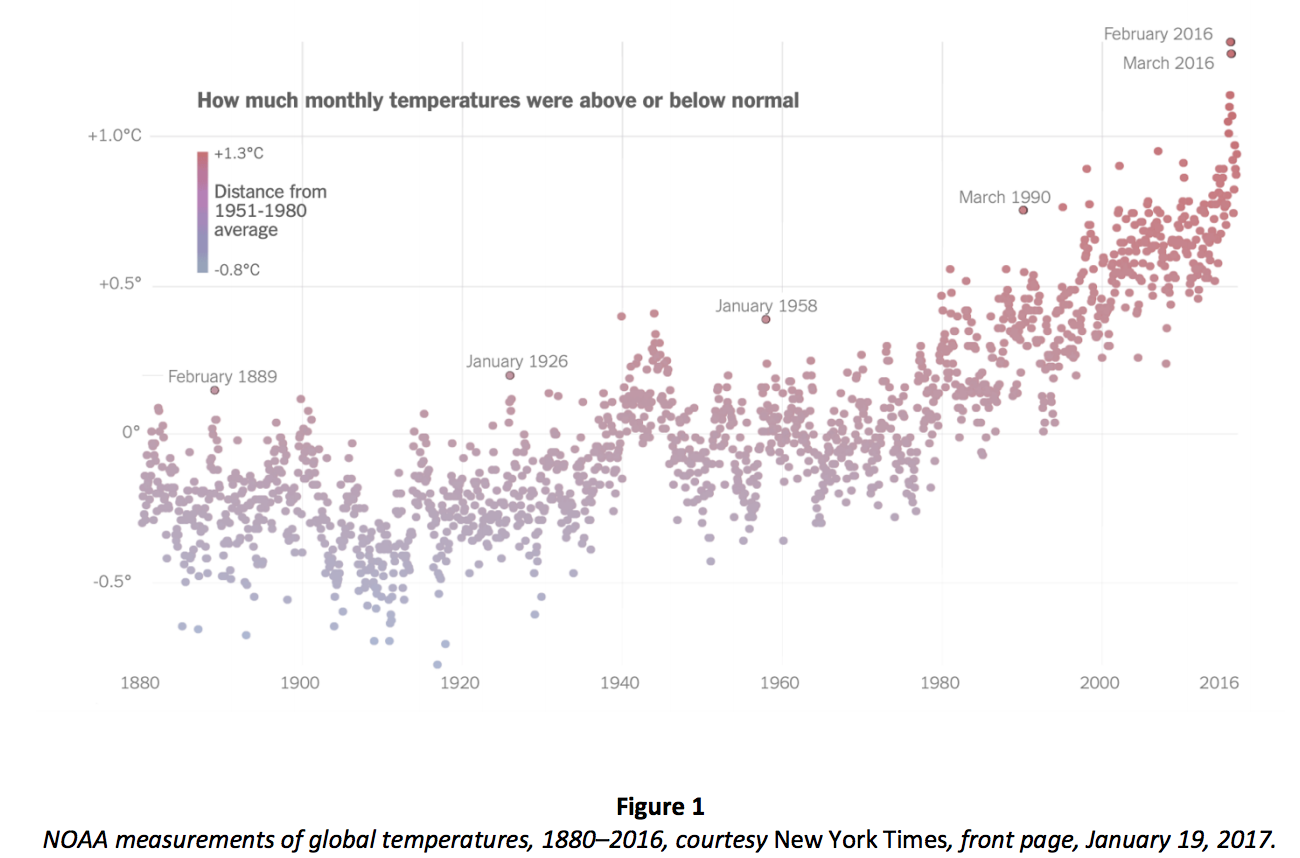
But it was noticeable to Gottschalk’s expert eye. He decided to see whether or not the WW2 temperature bump was a robust feature of the NOAA data. He applied what statisticians call ‘curve fitting’ techniques and ‘parametric analysis’ to eliminate the scatter in the data and discern the forest from the trees. He submitted his results to Cornell University’s online archive [Type here] 2 of scientific pre-publication articles in March 2017. Here is what Gottschalk’s curve-fitted ‘bump’ looks like.
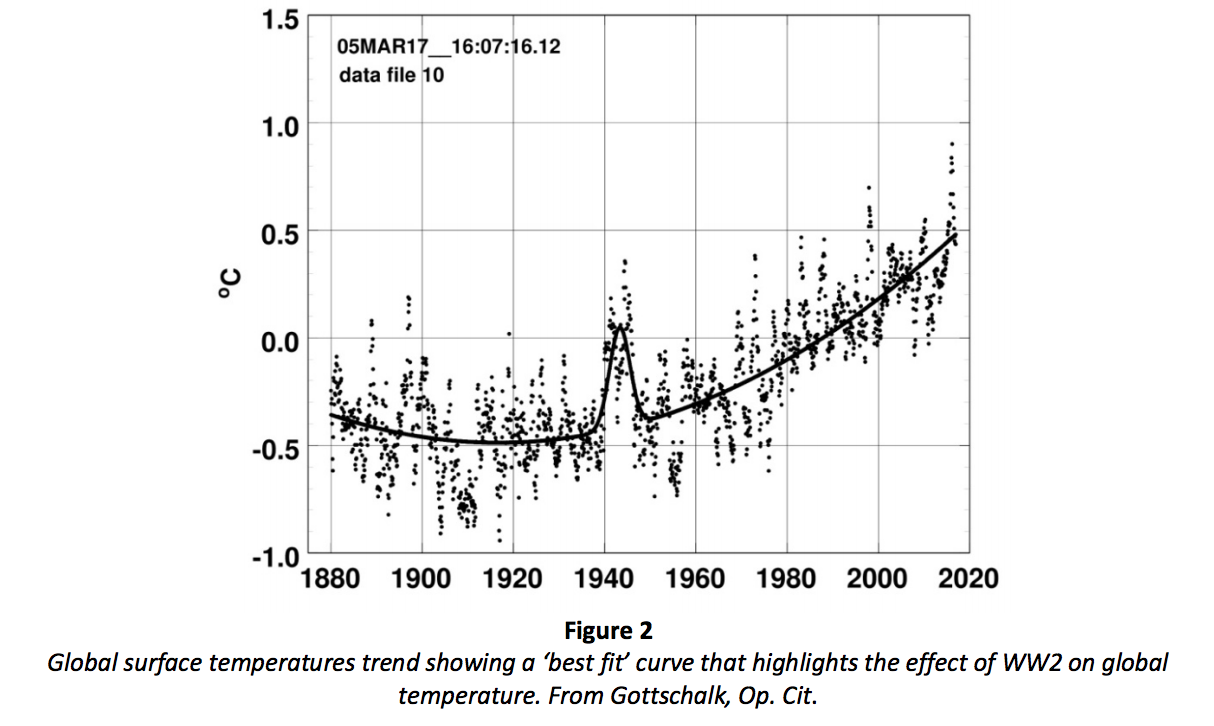
Gottschalk showed the rise-and-fall behaviors common to eight of the NOAA data-set measurements, four land-based and four ocean-based, during WW2.
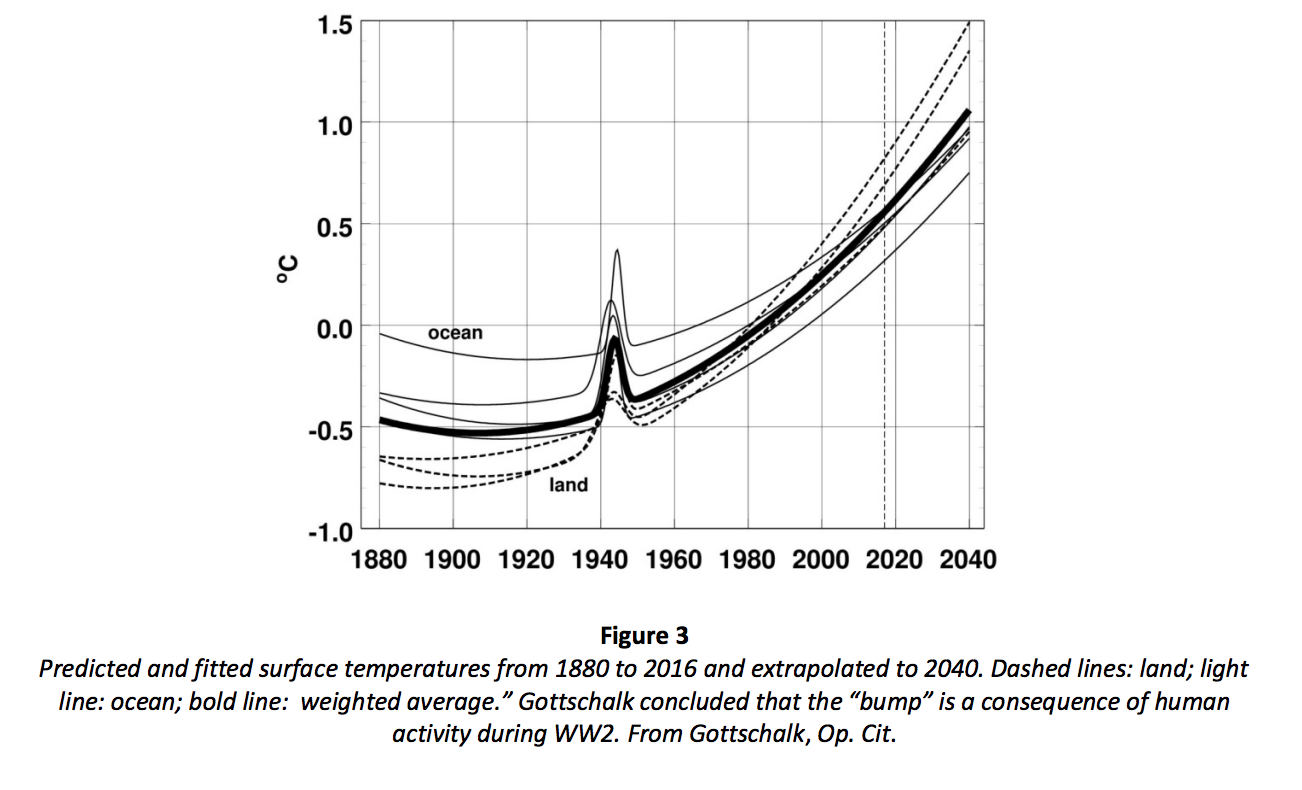
Of the possible explanations for the WW2 heat bump, Gottschalk concluded the “simplest and most likely” one was that it was “a consequence of human activity.” [1]
The following year, in 2018, a colleague showed Gottschalk’s online paper to geoscientist J Marvin Herndon. Herndon was immediately struck by the WW2 heat bump. If CO2 had caused the sudden rise in temperatures in 1939, their abrupt fall in late 1945 and 1946 could not have happened, because CO2 has a very long residence time in the atmosphere. Once in the atmosphere, CO2 and its presumed heat effects don’t suddenly disappear.
Moreover, ice core data showed “no significant increase in CO2 during the war years 1939– 1945.” [2] What then could have ramped up the heat in 1939-40 and subsequently caused it to plummet in 1946, after the war had ended?
Gottschalk’s WW2 temperature bump was a provocative anomaly in the 136-year global heat record, especially given the ‘consensus’ that anthropogenic CO2 is the primary cause of global warming.
Herndon surmised that unlike greenhouse gases, air pollution particles have a short residence time in the lower atmosphere, or troposphere, time measured in days and weeks. If war-related particulate air pollution had caused the heat bump, then Earth’s surface temperatures could be expected to fall abruptly with the cessation of global hostilities. As in fact happened.
Herndon decided “to consider the broader activities of WW2,” especially the role of particulate matter that might act to alter Earth’s delicate energy balance. Particulate air pollution is comprised of small, including microscopically small, solid or liquid particles light enough to float in air. Aerosols are particulates that are immersed in a gas or liquid and are produced by fires, fossil fuel use, agriculture, industry, mining, marine-aviation-and-vehicular transport (especially diesel), unpaved roads, construction and demolition, among other human activities, all producing dust (vehicular road traffic), fly ash (coal), soot (coal and diesel), smoke (forest fires), and fumes (mining and metallurgy).
Relative to earlier years, WW2 produced significantly more amounts of particulate aerosols.
“A great spike in wartime air pollution inevitably occurred from maximized industrial production,” Herndon wrote in his first of six papers on the role of particulate pollution in global warming, “from smoke and coal fly ash spewing out of smokestacks of industries, utilities, and locomotive engines, from greatly increased marine and aeronautical transport, and from extensive military activities that polluted the air with aircraft, ship, and vehicle exhaust and with the consequences of vast numbers of munition detonations.” [3]
Early in the war the Allies, possessing superior airpower and led by Great Britain’s Royal Air Force (RAF), developed the practice of ‘area bombing’—to an extent already carried out by Japan in China, and by Germany in Poland—that deliberately targeted civilian and non-military zones for wholesale demolition. [4] In early March 1945, to take but one notable example, [Type here] 4 hundreds of US B-29 Superfortress bombers dropped 1,700 tons of incendiary explosives over Tokyo, creating a firestorm that burned for days, incinerating 16 square miles and killing as many as 100,000 humans, all in one blow. The near-total instantaneous destruction of Hiroshima and Nagasaki five months later ended the war in the Pacific. By war’s end in 1945, the Allied Forces had dropped over 2.7 million tons of bombs in Europe alone, creating maelstroms of smoke, debris, dust, and soot, with fires that could rage for days.
Coal was still the world’s primary energy source during WW2, essential to iron and steel production, electricity generation, and rail transport, among other uses fundamental to the conduct of the war. The United States, the Allies’ industrial workhorse, consumed 12.5 quadrillion Btu of coal in 1940. By 1945 US coal consumption had grown to 16 quadrillion Btu. By 1949 US coal consumption had plummeted 25 percent to 12 quadrillion Btu—less than was consumed at the war’s outset. [5]
Herndon noted that “the aerosolized particulates settled to the ground after the war, Earth radiated its excess trapped energy, and global warming abruptly subsided. But only for a brief time, as particulate pollution began to rise again from ramped-up post-WW2 industrial growth, initially in Europe and Japan, and later in China, India, and the rest of Asia, dramatically increasing worldwide aerosol particulate pollution.” [6] Global warming soon resumed its steeply rising course.
Lacking “reliable, historical, global aerosol-particulate data” to measure the growth of particulate pollution during WW2, Herndon decided to use proxies “to demonstrate the reasonableness of the proposition that increases in aerosolized particulates over time is principally responsible for the global warming increase.” [7] To Gottschalk’s figure (see Figure 3 above) he added three “relative-value” proxy curves illustrating three major industrial sources of air pollution: global coal and oil production, and global aviation fuel consumption. When burned, these fuels emit both gases and aerosol particulates.
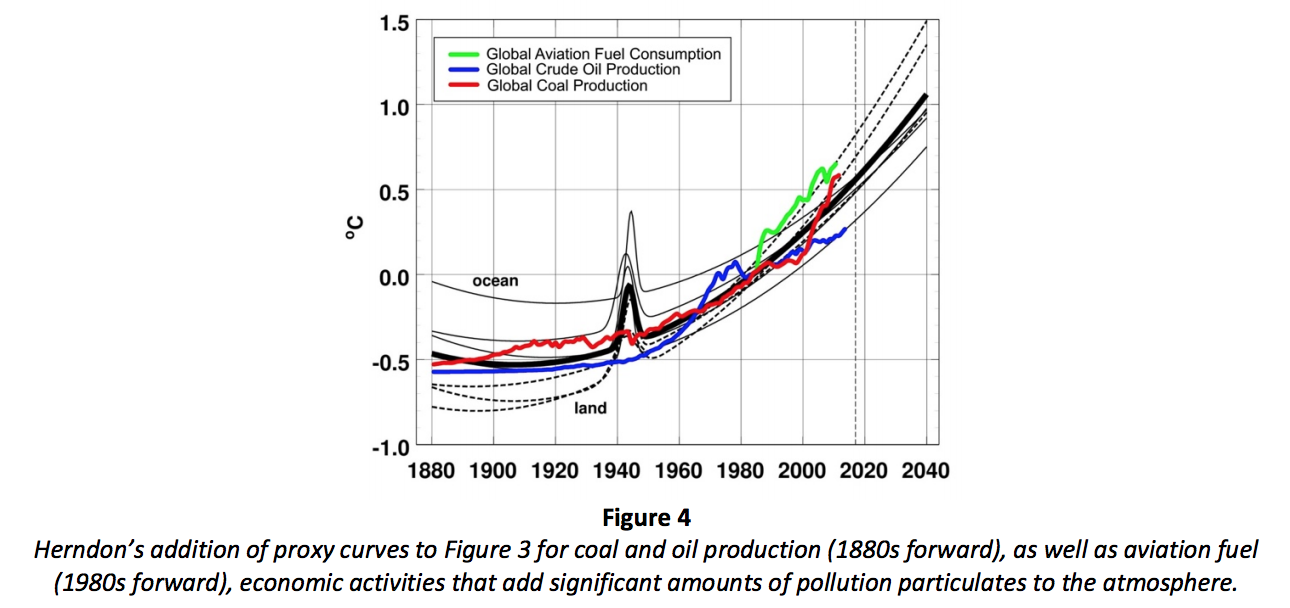
With Herndon’s first peer-reviewed paper on the subject published in September 2018, Gottschalk’s WW2 heat bump due to “human activity” launched a serious scientific case for particulate pollution as the primary, unheralded anthropogenic cause of global warming.
The question that needed to be answered was: How do particulate aerosols alter Earth’s delicate thermal balance? How do they heat the planet?
To maintain its thermal balance, “Earth must return to space virtually all the energy it receives from the sun as well as the energy it produces internally.” [8] The two most important ways Earth thermoregulates are via convection, the “mass-transport of energy” in the lower atmosphere or troposphere, and via infrared radiation from Earth’s surface. According to Herndon, the climate science community focuses almost exclusively on the role of radiation transport, and generally “fails to understand the significant role atmospheric convection plays” in the removal of heat from Earth’s surface. [9]
The troposphere is the lowest region of Earth’s atmosphere, the region where the air mixes and roils, where 99 percent of Earth’s water vapor is, and where the weather happens. It is also the region where convection—the uptake of Earth’s surface heat—occurs.
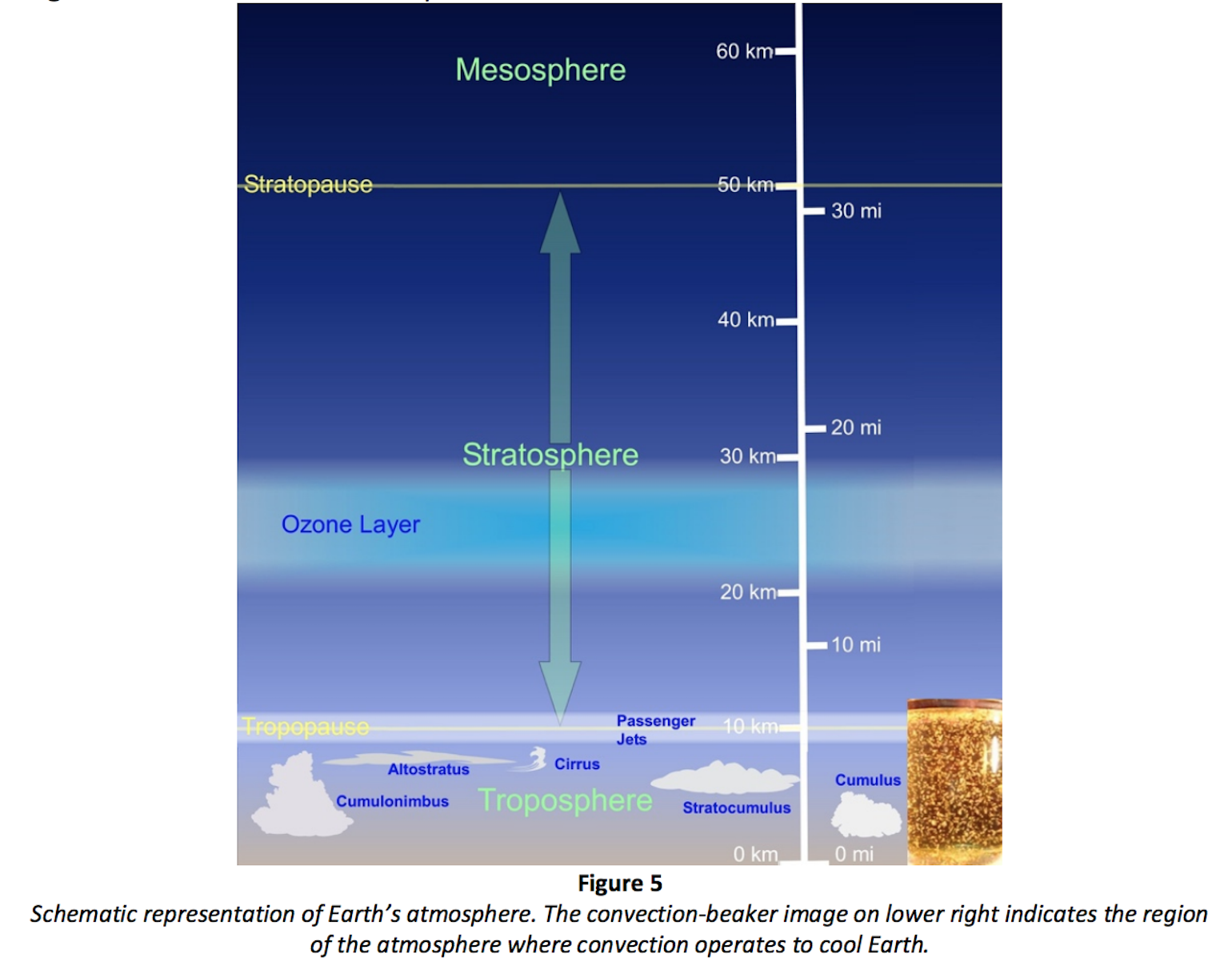
Convection is a natural, ongoing, and constant process whereby the heat from Earth’s surface is transported to the upper troposphere, and from there eventually back into space. It is driven by the temperature difference between the upper and lower surface layers of air in the troposphere. (The Greek tropo means turning or changing.) Hotter, lighter surface air rises and colder, denser air falls, driving the atmosphere’s turbulence, which allows heat to escape. This difference in temperatures between layers causes the natural disturbance that is the troposphere’s signature characteristic, its continually changing movement of air, moisture, and weather.
Convection’s efficiency depends on what scientists call the ‘adverse temperature gradient’, meaning the amount or degree of difference between Earth’s surface atmospheric temperature and its upper troposphere temperature. The less difference, the less adverse temperature gradient. The less adverse temperature gradient, the less efficient the removal of Earth’s surface heat by convection.
To show how convection works, Herndon described a simple classroom-demonstration experiment in which he used “a 4 liter beaked-beaker, nearly filled with distilled water, and heated on a regulated hot plate.” As an indicator of convection, celery seeds were added to be “dragged along by convective motions in the water.” Due to the constantly maintained temperature difference between the heated bottom and the cooler top of the beaker, with heat venting out the top, a constant, regular circulation of the fluid was established, signaled by the movement of the seeds. “When stable convection was obtained a ceramic tile was placed atop the beaker to retard heat loss, thereby increasing the temperature at the top relative to that at the bottom, thus decreasing the adverse temperature gradient.” [10]
The whole process was videotaped. [11]
The video shows a dramatic reduction in convection when the lid is placed on top of the beaker, with a “markedly” rapid decrease in the movement of the beaker’s celery seeds, “demonstrating the principle that reducing the adverse temperature gradient decreases convection” and warms the planet. In other words, don’t place an aerosols-pollution ‘lid’ on the open tropospheric air beaker if you want Earth to thermoregulate properly. There is a common misunderstanding, both among climate scientists and the press covering future geoengineering schemes, that air particulate pollution acts to shut out sunlight and cool the atmosphere. This does in fact happen when particulates are placed deep in the stratosphere—high above the troposphere, which itself only extends to about 10 km or 6-7 miles above sea level. We have seen the example of the 1991 Mt. Pinatubo eruption, when the Philippine volcano “ejected 20 million tons of sulfur dioxide…more than 1 cubic mile of material that rose in an ash cloud 22 miles into the air” deep inside the stratosphere “and caused global temperatures to drop from 1991 to 1993 by about 1º F (0.5º C).” [12].
But air particulate pollution is primarily a tropospheric phenomenon, not a stratospheric one.
Indian scientists, measuring the heating rates of the lower atmosphere over the Indian Ocean, found that the “atmospheric heating rate…due to aerosol over the tropical Indian Ocean was many times larger than that due to CO2.”[14] Coal fly ash is a known efficient radiation absorber, prominently due to its components of iron, iron oxides such as hematite and magnetite, carbon and carbon black, as well as other elements (e.g., aluminum, magnesium). India is heavily dependent on coal and mortally dependent on its monsoon. Recently Indian researchers used state-of-the-art instruments to measure the effects of pollution particulates such as black carbon on the movement of the monsoon. They discovered a “higher amount” of black carbon particulates that “can disturb the normal upward movement of moist air” because they heat the atmosphere and reduce convection. [15]
The adverse thermal gradient directly affects the lives of billions of human beings. And not only in Asia, but the whole world.
“The one generalization that can now be made,” Herndon asserts in his sixth and most recently published paper, “is that virtually all tropospheric aerosol particulates, including cloud droplets and their aerosol components, absorb short- and long-wave solar radiation, and absorb longwave radiation from Earth’s surface.” [16]
When millions of tons of heat-absorbing particulate pollution in the form of soot, dust, smoke, and coal fly ash are deposited in the troposphere they heat the surrounding air masses and, acting as a lid on the atmospheric ‘beaker’, they directly lower the adverse temperature gradient between Earth’s surface and the troposphere’s upper layer. Such interference directly reduces atmospheric convection and allows incident solar radiation to build up and warm the planet.
Herndon concludes: “The lowering of the adverse temperature gradient in the lower atmosphere is the primary way global particulate pollution causes global warming.” [17]
The Geoengineering Stakes
Over the last two decades geoengineering has been much discussed and hyped as a possible anthropogenic antidote to human-caused CO2 global warming. The two have been coupled as a single problem/solution conundrum in the minds of scientific and political elites at least since the National Academy of Sciences’ massive 1992 report Policy Implications of Greenhouse Warming. [18] The ‘the Pinatubo option’ of ameliorating CO2-caused heat by spraying millions of tons of sulfur dioxide or aluminum nanoparticulates into the stratosphere, what geoengineers call ‘stratospheric radiation management’, is their currently favored solution to the problem of global warming. [19] And political elites are peering over the engineers’ shoulders with close attention to the political intricacies of eventual implementation. [20]
The problems with this ‘solution’ are manifold and obvious, yet underappreciated. The problem posed, for instance, by aerosolized pollution nanoparticulates to the stratospheric ozone layer, which shields the entire biosphere from ultraviolet radiation, though mentioned, is rarely stressed. Even in the dry stratosphere, which is far less turbulent than the moisture-laden troposphere, gravity operates. Particulates precipitate out, falling first into the troposphere where the weather occurs in form of rain and drought (among other events), and from the troposphere onto agricultural fields and gardens, into reservoirs and lakes, into the ocean, and into vertebrate lungs.
Even though the residence time of particulates in the stratosphere is measured in years (one, two, or three), not days and weeks, to keep ‘managing’ incoming solar radiance the stratospheric pollutant shield will have to be continuously renewed, and aerosols more or less constantly sprayed, at least for decades, and possibly longer. [21]
Leaving the long-term effects on local, regional, and global weather systems aside, once in the troposphere aerosols have mortal effects. Indeed, humanity and all other living beings would have to adapt to unprecedented levels of invisible aerosol pollution whose health effects are known [22] but grossly underappreciated. Last October the head of WHO warned that “the simple act of breathing is killing 7 million people a year and harming billions more.” He added that “air pollution now causes more deaths annually than tobacco,” and that “over 90% of the world’s population suffers toxic air…with profound impacts on the health of people, especially children.” [23].
There is, as readers of Herndon’s [24] or my work [25] know, another form of geoengineering. It takes place in the lower atmosphere, and constitutes a different, covert kind of enterprise, conducted by the military and its subcontractors, whose purpose can only be speculated upon.
What can no longer be denied, however, is that deep state tropospheric geoengineering’s principal and most significant result is to warm the planet.
In the early post-WW2 years John von Neumann, one the last century’s most influential scientists and mathematicians, claimed that “using computer-generated predictions…weather and climate systems ‘could be controlled, or at least directed, by the releases of perfectly practical amounts of energy’.” [26] Humans now possess those ‘perfectly practical amounts of energy’ in the form of globally dispersed ionospheric heaters and electrically conducting aerosols.
Toward the end of his life, von Neumann pronounced: “All stable processes we shall predict. All unstable processes we shall control.” [27]
Von Neumann spoke for a community whose power has grown steadily over the last 60 years, the community Eisenhower warned of in his Farewell Address. The weather and the climate are preeminent examples of ‘unstable processes’ whose complexities, though huge, do not appear to daunt von Neumann’s scientific and military heirs.
Meanwhile, our civilization is profoundly dependent on fossil-fuel energy. Virtually all official sources indicate that we will remain heavily dependent on fossil fuels for at least another generation. Given our dependency, there are two reasons for optimism.
One, it is technically more feasible to reduce particulate air pollution than to reduce carbon dioxide.
Two, if the NOAA WW2 temperature data as interpreted by Gottschalk and by Herndon is correct, then reducing particulate emissions will have an immediate beneficial effect on global warming.
Ian Baldwin is an environmentalist and co-founder of Chelsea Green Publishing Company in Vermont. He has written on geoengineering issues under the rubric “Our Geoengineering Age” at www.vermontindependent.net.”
Notes:
[1] Bernard Gottschalk, “Global surface temperatures trends and the effect of World War II: a parametric analysis (long version),” arXiv, March 19, 2017; expanded October 15, 2018. http://arxiv-export-lb.library.cornell.edu/pdf/1703.09281. Accessed Sep 06, 2019.
[2] J Marvin Herndon & Mark Whiteside, “Further Evidence that Particulate Pollution is the Principal Cause of Global Warming: Humanitarian Considerations,” Journal of Geography, Environment and Earth Science International, 21 (1), May 08, 2019. http://www.journaljgeesi.com/index.php/JGEESI/article/view/30117. Accessed Sep 06, 2019.
[3] J Marvin Herndon, “Air Pollution, Not Greenhouse Gases: The Principal Cause of Global Warming,” Journal of Geography, Environment and Earth Science International, 17 (2), September 22, 2018. http://www.journaljgeesi.com/index.php/JGEESI/article/view/11231. Accessed Sep 06, 2019.
[4] Richard Overy, The Bombing War: Europe 1939–1945 (London: Penguin, 2014).
[5] “History of Energy Consumption in the United States, 1775–2009,” US Energy Information Administration, February 09, 2011. https://www.eia.gov/todayinenergy/detail.php?id=10. Accessed Sep 06, 2019.
[6] J Marvin Herndon “Role of Atmospheric Convection in Global Warming,” Journal of Geography, Environment and Earth Science International, 19 (4), March 13, 2019. http://www.journaljgeesi.com/index.php/JGEESI/article/view/30091. Accessed Sep 06, 2019.
[7] Herndon, “Air Pollution, Not Greenhouse Gases…,” Op. Cit.
[8] J Marvin Herndon, “Fundamental Climate Science Error: Concomitant Harm to Humanity and the Environment,” Journal of Geography, Environment and Earth Science International, 18 (3), December 28, 2018. http://journaljgeesi.com/index.php/JGEESI/article/view/28790. Accessed Sep 06, 2019.
[9] Herndon, “Further Evidence…”, Op. Cit.
[10] Ibid. [Type here] 10
[11] https://www.youtube.com/watch?v=gFD6VoL3F_s&feature=youtu.be.
[12] Herndon, “Further Evidence…”, Op. Cit.
[13] Ian Baldwin, “Origins of the ‘Climate Change’ Threat to National Security—and the Geoengineering Response,” vermontindependent.net, June 13, 2017. https://vermontindependent.net/origins-of-the-climate-change-threat-to-national-securityand-the-geoengineering-response-our-geoengineering-age-part-6/. Accessed Sep 06, 2019.
[14] M V Ramana et al, “Albedo, atmospheric solar absorption and heating rate measurements with stacked UAVs,” Quarterly Journal of the Royal Meteorological Society, 133 (629), September 18, 2007. https://www.academia.edu/25247234/Albedo_atmospheric_solar_absorption_and_heating_ra te_measurements_with_stacked_UAVs. Accessed Sep 06, 2019.
[15] Shamitaksha Talukdar et al, “Influence of Black Carbon Aerosol on the Atmospheric Instability,” Journal of Geophysical Research: Atmospheres, 124 (10), April 29,2019. https://agupubs.onlinelibrary.wiley.com/doi/10.1029/2018JD029611. Accessed Sep 06, 2019.
[16] J Marvin Herndon, “Geophysical Consequences of Tropospheric Particulate Heating: Further Evidence that Anthropogenic Global Warming is Principally Caused by Particulate Pollution,” Journal of Geography, Environment and Earth Science International, 22 (4), August 19, 2019. http://journaljgeesi.com/index.php/JGEESI/article/view/30157. Accessed Sep 06, 2019.
[17] Herndon, “Role of Atmospheric Convection…”, Op. Cit.
[18] Baldwin, Op. Cit.
[19] Douglas G MacMartin, Katharine L Ricke & David W Keith, “Solar Geoengineering as Part of an Overall Strategy for Meeting the 1.5 Degrees Celsius Paris Target,” Philosophical Transactions of the Royal Society A: Mathematical, Physical and Engineering Sciences, April 02, 2018. https://royalsocietypublishing.org/doi/abs/10.1098/rsta.2016.0454. Accessed Sep 07, 2019.
[20] Oliver Geden & Susanne Dröge, “The Anticipatory Governance of Solar Radiation Management,” Council on Foreign Relations, July 02, 2019. https://www.cfr.org/report/anticipatory-governance-solar-radiation-management. Accessed Sep 07, 2019.
[21] David Keith, A Case for Climate Engineering (Cambridge: MIT Press, 2013). [Type here] 11
[22] Mark Whiteside & J Marvin Herndon, “Geoengineering: The Deadly New Global ‘Miasma’,” Journal of Advances in Medicine and Medical Research, 29 (12), June 20, 2019. http://www.journaljammr.com/index.php/JAMMR/article/view/30151. Accessed Sep 06, 2019.
[23] Damian Carrington & Matthew Taylor “Air pollution is the ‘new tobacco’, warns WHO head,” The Guardian, October 27, 2018. https://www.theguardian.com/environment/2018/oct/27/air-pollution-is-the-new-tobaccowarns-who-head. Accessed Sep 06, 2019.
[24] http://nuclearplanet.com/Geoengineering_Science_Articles.html.
[25] https://vermontindependent.net/geoengineering-for-real-the-latest-research-revealed/.
[26] James R Fleming “The Climate Engineers,” The Wilson Quarterly, Spring 2007. http://archive.wilsonquarterly.com/essays/climate-engineers. Accessed Sep 06, 2019.
[27] Ibid.

